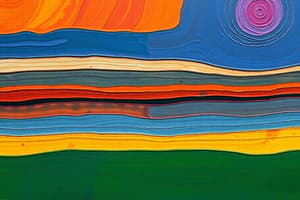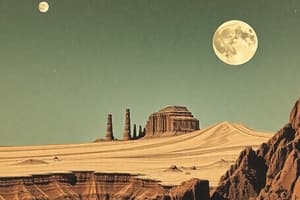Podcast
Questions and Answers
Which layer of the Earth is primarily composed of liquid iron and nickel?
Which layer of the Earth is primarily composed of liquid iron and nickel?
- Lithosphere
- Outer core (correct)
- Asthenosphere
- Inner core
What is the primary function of the Earth's atmosphere?
What is the primary function of the Earth's atmosphere?
- To support water retention in the hydrosphere
- To maintain tectonic plate movement
- To provide heat to the crust
- To regulate temperatures and protect from radiation (correct)
Which part of the Earth is known for being solid and rigid, broken into tectonic plates?
Which part of the Earth is known for being solid and rigid, broken into tectonic plates?
- Hydrosphere
- Lithosphere (correct)
- Mantle
- Barysphere
What is the significance of the hydrosphere on Earth?
What is the significance of the hydrosphere on Earth?
Which statement about the inner core is correct?
Which statement about the inner core is correct?
What is the primary characteristic of the lithosphere?
What is the primary characteristic of the lithosphere?
Which of the following correctly describes the composition of the Earth's crust?
Which of the following correctly describes the composition of the Earth's crust?
What is the thickness of the hydrosphere compared to the lithosphere?
What is the thickness of the hydrosphere compared to the lithosphere?
Which layer is described as being almost invisible?
Which layer is described as being almost invisible?
What happens to temperature as one moves deeper towards the center of the Earth?
What happens to temperature as one moves deeper towards the center of the Earth?
Study Notes
Earth's Structure and Composition
- Earth is the only known planet that supports life and consists of four main layers: barysphere, lithosphere, hydrosphere, and atmosphere.
- Barysphere: Refers to the dense core, primarily made of iron and nickel, critical for generating Earth's magnetic field.
- Lithosphere: The rigid outer layer that includes the crust and upper mantle, composed of tectonic plates that rest on the more fluid asthenosphere.
- Hydrosphere: Encompasses all water bodies including oceans, rivers, lakes, and glaciers, crucial for weather and climate regulation.
- Atmosphere: The gaseous layer surrounding Earth includes the troposphere, stratosphere, mesosphere, and thermosphere; essential for providing oxygen and protecting from solar radiation.
Layer Characteristics
- Inner Core: Deepest layer, composed of solid iron and nickel.
- Outer Core: Located beneath the mantle, comprised of liquid iron and nickel.
- Mantle: Made of molten iron and minerals, behaves as a viscous plastic under pressure.
- Crust: The outermost layer where life exists, consisting of granite (lighter) and basalt (heavier) rocks, with varying thickness.
Greek Origins of Terms
- Barysphere: Derives from "bary" meaning heavy, highlighting its dense composition.
- Lithosphere: Comes from "lithos" meaning stone, indicating its solid structure.
- Hydrosphere: Originates from "hydro" meaning water, encompassing all aquatic bodies.
- Atmosphere: From "atmos" meaning air, signifying the gaseous layer.
Measurements and Comparisons
- Earth's diameter is approximately 8,000 miles, with each layer represented in a scale:
- Lithosphere is about 23 miles thick.
- Hydrosphere measures around 2.5 miles thick.
- Barysphere thickness is comparable to the length of a meter stick.
- Lithosphere and hydrosphere represent 2/16 and 1/16 of a meter stick, respectively.
- Atmosphere is nearly invisible in comparison.
Thermal Gradients and Composition
- Temperature increases towards Earth's center, reaching 135°F.
- Mantle thickness is roughly 1,800 miles, while the total core depth is around 3,000 miles.
- Crust is believed to be the thinnest layer, with a composition of granite (lighter) and basalt (heavier) rocks forming tectonic plates.
Geological Processes
- Heavier components sink to the Earth's core, while lighter elements float above, forming the crust and mantle.
- The crust is not a solid shell but consists of tectonic plates that move.
Studying That Suits You
Use AI to generate personalized quizzes and flashcards to suit your learning preferences.
Related Documents
Description
Test your knowledge on the Earth's layers and their characteristics in this comprehensive quiz. Explore the barysphere, lithosphere, hydrosphere, and atmosphere, and understand their roles in supporting life. Perfect for students and anyone interested in geology.




